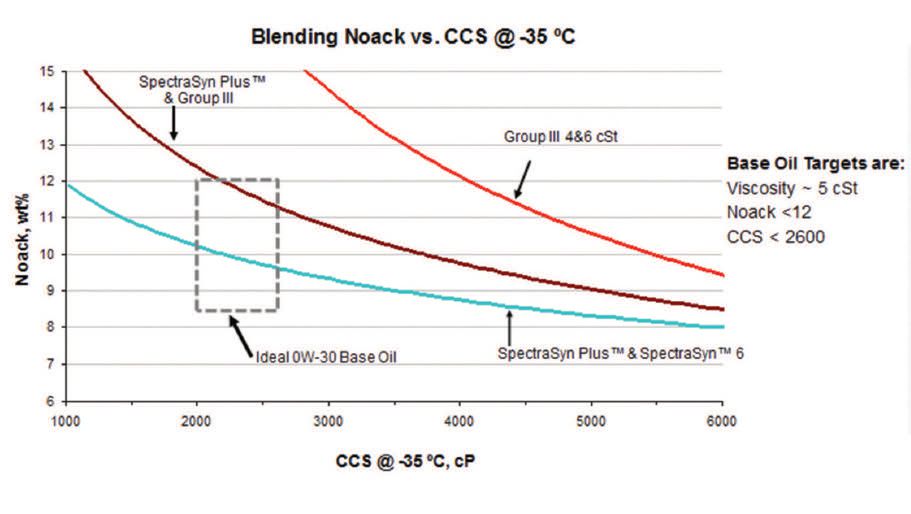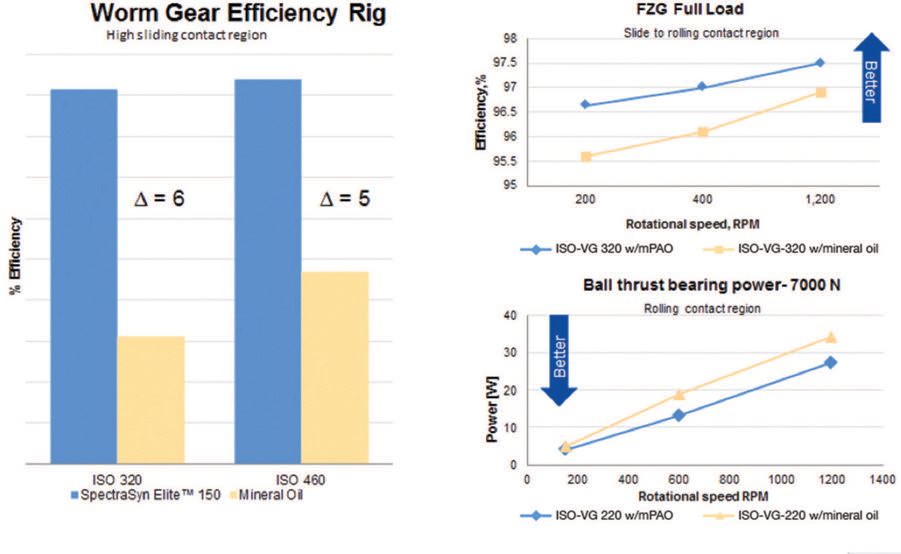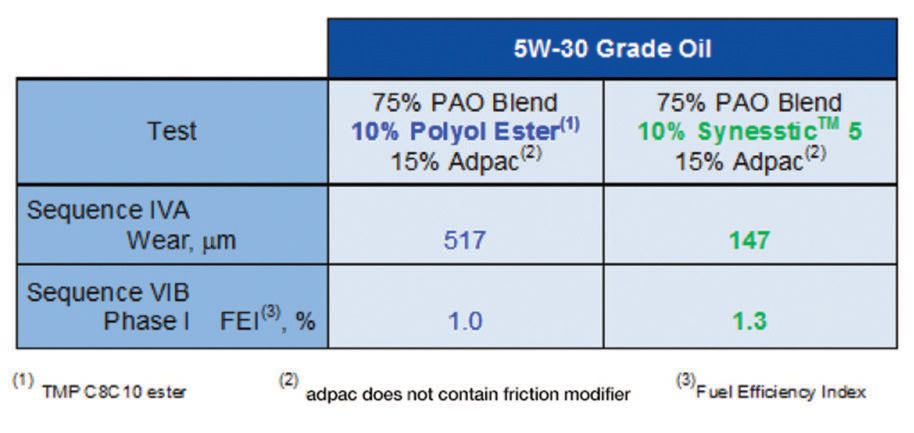ExxonMobil Chemical
Synthetic Solutions for Tomorrow’s Lubricants
By Michael P. Sheehan, Marketing Technical Services, ExxonMobil Chemical Company | TLT CMF Plus November 2014

The lubricant marketplace is changing. And these changes, driven by evolving needs and expectations, are creating unprecedented challenges for today’s lubricant formulators.
They must meet the complex performance requirements and specifications established by Original Equipment Manufacturers (OEMs), while complying with tighter global regulations. Their finished lubricant formulations must provide better equipment protection and higher performance, while at the same time improving fuel economy and reducing emissions.
The automotive market demands lubricants with lower viscosity, improved low-temperature fluidity, better thermal, oxidative and shear stability, as well as reduced volatility for longer drain intervals. Along with these capabilities, industrial lubricants have to deliver improved hydrolytic stability and enhanced air-release properties. Manufacturing trends toward smaller equipment with higher energy output and longer machine run time will generate increasingly hotter and harsher operating conditions that stress lubricants as never before.
Energy efficiency
What’s driving these trends? Primarily: efficiency to offset the global growth in energy demand. ExxonMobil’s “Outlook for Energy” projects that by 2040 the world’s population will increase by two billion people. China and India, the world’s most populated countries, will account for much of the growth in population and energy demand. The “Outlook for Energy” also projects the world’s light-duty vehicles will double in number from about “800 million to about 1.7 billion.” Global efforts to con serve energy and reduce greenhouse gases are critical to the future, and governments continue to tighten regulations.
Synthetic base stocks solutions
In order to meet these challenges, lubricant formulators need to develop innovative, energy-efficient products, and that’s why so many of them turn to the broad portfolio of advanced technology base stock solutions available from ExxonMobil Chemical.
These synthetic solutions can help finished automotive and industrial lubricants enhance energy efficiency by reducing friction – a significant cause of energy loss – compared to lubricants formulated with mineral oil base stocks. Because of their molecular structure, synthetic base stocks, such as polyalphaolefins (PAOs), help reduce traction in finished lubricants, minimizing friction and thereby allowing lubricant manufacturers to deliver the energy efficiency their customers demand. Synthetic base stocks also help provide durability. Lubricants that can maintain viscosity grade and film strength longer don’t need to be replaced as often – an essential quality in today’s marketplace.
Polyalphaolefins
Conventional PAOs have proven through the years that they can help improve the capabilities of finished lubricants in key performance areas, such as low-temperature fluidity and long drain intervals, when compared to mineral oil-based base stocks. ExxonMobil Chemical offers a step up from conventional PAOs with its SpectraSyn Plus™ PAO.
Through its low viscosity, low volatility and low-temperature fluidity, SpectraSyn Plus PAO is an outstanding solution for formulators striving to meet government regulations requiring better fuel economy and lower emissions. To achieve these goals, formulators have shifted their focus to blending lower viscosity, longer lasting oils. SpectraSyn Plus PAO can help them with this challenge by delivering improved volatility and low-temperature properties compared to standard low-viscosity PAOs.
SpectraSyn Plus PAO also gives formulators cost-effective flexibility. They can blend a 0W-30 engine oil, for example, with Group III base stocks along with SpectraSyn Plus PAO to achieve their ideal quality targets. The blending flexibility and enhanced performance supplied by SpectraSyn Plus PAO make it a powerful solution to the challenges formulators face today. (See
Figure 1)
Test Method: ASTM D5293
 Figure 1. This chart shows how SpectraSyn Plus™ PAO, due to its exceptional low volatility and low-temperature fluidity, supplies flexible, cost-effective solutions in order to meet complex OEM performance requirements.
Figure 1. This chart shows how SpectraSyn Plus™ PAO, due to its exceptional low volatility and low-temperature fluidity, supplies flexible, cost-effective solutions in order to meet complex OEM performance requirements.
Source: ExxonMobil data.
Metallocene polyalphaolefins
Through a proprietary metallocene catalyst process, ExxonMobil Chemical engineered yet another solution for formulators striving to meet current and future demands: SpectraSyn Elite™ metallocene polyalphaolefin (mPAO). This groundbreaking advanced synthetic base stock possesses all the capabilities of conventional high viscosity PAOs, but with higher viscosity index, better shear stability and improved low-temperature properties.
These enhanced characteristics help formulators achieve outstanding performance over a wide temperature range. SpectraSyn Elite offers improved energy efficiency and cold-start capability, as well as long drain intervals and strong product durability to ensure wear protection. With its exceptional blending flexibility, SpectraSyn Elite mPAO can be used in combination with lower-viscosity fluids, such as PAO and mineral oils, to achieve a broad array of industrial and automotive lubricants and greases. (See
Figure 2)
 Figure 2. The three comparison charts above demonstrate the superiority of SpectraSyn Elite™ mPAO
Figure 2. The three comparison charts above demonstrate the superiority of SpectraSyn Elite™ mPAO
over mineral oil-based products in enabling higher energy efficiencies.
Source: ExxonMobil data.
Alkylated naphthalene
Because today’s smaller equipment runs hotter – which increases oxidation that can lead to corrosion and oil thickening – formulators need base oils that provide thermal and oxidative stability while maintaining bearing and seal protection. They also want a base oil with excellent solvency to reduce sludge and engine deposits. To help with all of these concerns, ExxonMobil Chemical offers Synesstic™ Alkylated Naphthalene (AN).
Synesstic AN supplies exceptional solubility while minimizing competition for the metal surface, allowing polar additives to perform at optimum levels in finished lubricants, which can improve durability and efficiency. This increased durability helps extend drain intervals, a high priority for formulators today. (See
Figure 3)
 Figure 3. These tests with 5W-30 grade oil demonstrate how Synesstic™ AN complements additives to
Figure 3. These tests with 5W-30 grade oil demonstrate how Synesstic™ AN complements additives to
improve durability and efficiency.
Source: ExxonMobil data.
Committed to solutions
Through one of the industry’s most comprehensive portfolios of commercially available Group IV and V base stocks, ExxonMobil Chemical remains committed to providing formulators with the flexible solutions they need to create innovative lubricants for the evolving marketplace. The company further demonstrates its commitment with significant investment in production facilities that ensure reliable global supply of high-quality synthetic base stocks.
With the assurance of global product registrations and specialty certifications, formulators can use these synthetic base stocks with confidence, knowing their finished products comply with regulations, which enables increased speed to market.
Ultimately, ExxonMobil Chemical offers a full suite of solutions that supports customers today and prepares them for tomorrow.
©2014 ExxonMobil. ExxonMobil, the ExxonMobil logo, the interlocking “X” device and other product or service names used herein are trademarks of ExxonMobil, unless indicated otherwise. This document may not be distributed, displayed, copied or altered without ExxonMobil’s prior written authorization. To the extent ExxonMobil authorizes distributing, displaying and/or copying of this document, the user may do so only if the document is unaltered and complete, including all of its headers, footers, disclaimers and other information. You may not copy this document to or reproduce it in whole or in part on a website. ExxonMobil does not guarantee the typical (or other) values. Any data included herein is based upon analysis of representative samples and not the actual product shipped. The information in this document relates only to the named product or materials when not in combination with any other product or materials. We based the information on data believed to be reliable on the date compiled, but we do not represent, warrant, or otherwise guarantee, expressly or impliedly, the merchantability, fitness for a particular purpose, freedom from patent infringement, suitability, accuracy, reliability, or completeness of this information or the products, materials or processes described. The user is solely responsible for all determinations regarding any use of material or product and any process in its territories of interest. We expressly disclaim liability for any loss, damage or injury directly or indirectly suffered or incurred as a result of or related to anyone using or relying on any of the information in this document. This document is not an endorsement of any non-ExxonMobil product or process, and we expressly disclaim any contrary implication. The terms “we,” “our,” “ExxonMobil Chemical” and “ExxonMobil” are each used for convenience, and may include any one or more of ExxonMobil Chemical Company, Exxon Mobil Corporation, or any affiliate either directly or indirectly stewarded. Photos used in this brochure are representative of potential product applications only.